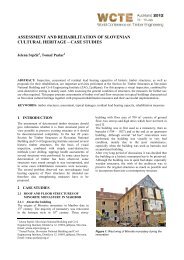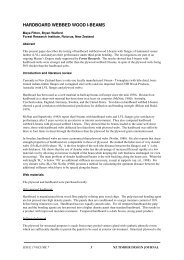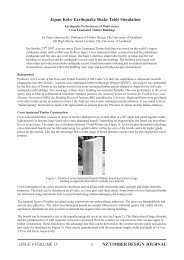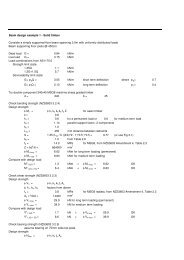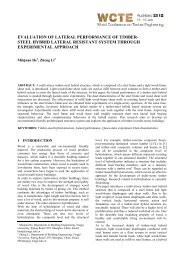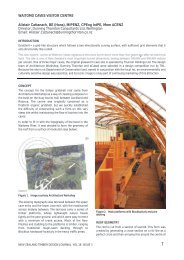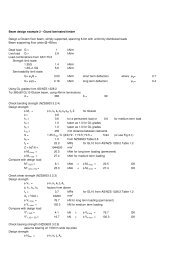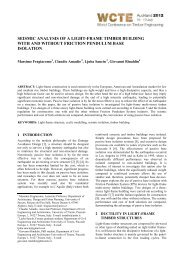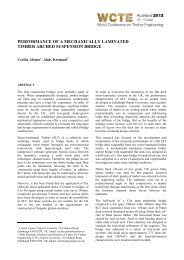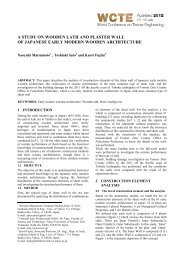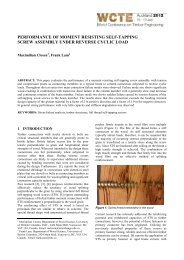Glulam Timber Structures - Timber Design Society
Glulam Timber Structures - Timber Design Society
Glulam Timber Structures - Timber Design Society
Create successful ePaper yourself
Turn your PDF publications into a flip-book with our unique Google optimized e-Paper software.
These notes have suggestions for:<br />
• Manufacturing functional products<br />
• Achieve Cost effective and practical timber solutions<br />
To assist:<br />
• Concept <strong>Design</strong>er<br />
• Architect<br />
• Engineer<br />
• Manufacturer<br />
• Constructor<br />
GETTING THE DETAILS RIGHT<br />
<strong>Design</strong> Notes – <strong>Glulam</strong> <strong>Timber</strong> <strong>Structures</strong><br />
Owen Griffiths 1<br />
Manufacturing Specifications and Standards<br />
Use Appropriate Specification<br />
• NZS 3606 is Dead !!<br />
• No More No 1 Framing, Engineering etc<br />
• <strong>Glulam</strong> – ASNZS 1328<br />
<strong>Design</strong> Values<br />
Some specifiers are still using NZS3606 as the current code for manufacture of <strong>Glulam</strong>. This has been replaced for some time by the<br />
joint Australian and New Zealand Code ASNZS1328.<br />
In specifying the grades from which <strong>Glulam</strong> beams are manufactured some designers are still using non current grades such as<br />
Engineering and No 1 framing. These have been replaced by the GL grades detailed in ASNZS 1328.<br />
1<br />
Owen Griffiths, Marketing Director, McIntosh <strong>Timber</strong> Laminates Ltd<br />
Volume 15 ISSUE 2 21 NZ TIMBER DESIGN JOURNAL
Other codes relevant to developing <strong>Glulam</strong> designs are:<br />
Finger Jointing – ASNZS 1491<br />
This controls manufacture of end joints in lamination.<br />
Preservative Treating – ASNZS – 1604<br />
Careful note should be taken as to the limitations of H3 penetration achievable using LOSP treatment. While this is satisfactory for<br />
H3.1 it does not provide the greater protection required for external use. Where LOSP is used for beams exposed to weather ASNZS<br />
3602 calls for LOSP treated beams to be protected with a paint coat in order to comply with durability requirements in exterior<br />
situations.<br />
In this case CCA treated material provides the required protection. CCA treatment is carried out on laminates before gluing.<br />
Use only licensed manufacturers<br />
Of utmost importance in using <strong>Glulam</strong> members is the need to specify product supplied by Licensed<br />
manufacturers. This is of particular importance bearing in mind liability issues if non licensed product is used<br />
in structural applications.<br />
Cost Effective Solutions<br />
Some basic considerations in achieving the most cost effective options in <strong>Glulam</strong> detailing.<br />
Choosing deeper narrowing members can save up to 50% volume in comparison to<br />
wider shallower selection.<br />
Figure 1<br />
The instability that might result from deep slender members can be controlled by<br />
careful detailing of stability struts or dropped purlins.<br />
Figure 2<br />
Volume 15 ISSUE 2 22 NZ TIMBER DESIGN JOURNAL
Functionality Cost Savings<br />
The design depicted in the lower diagram proves a 40% cost saving.<br />
Figure 3<br />
Economies in Curves<br />
Economies in curves is also affected by a number of choices. For example the difference between a solid knee curved portal with a<br />
radius of 3.0m and 1.2m would be approx 3% favoring the larger radius. However the saving by going to an open knee portal would<br />
be approx 30%<br />
+3%<br />
Base Cost<br />
Solid Knee<br />
Open Knee<br />
Figure 4<br />
Volume 15 ISSUE 2 23 NZ TIMBER DESIGN JOURNAL
Tapering Saves<br />
Tapering members instead of detailing rectangular sections allows cost savings in reducing section size in areas where loads are<br />
reduced<br />
-33%<br />
Figure 5<br />
Volume 15 ISSUE 2 24 NZ TIMBER DESIGN JOURNAL



